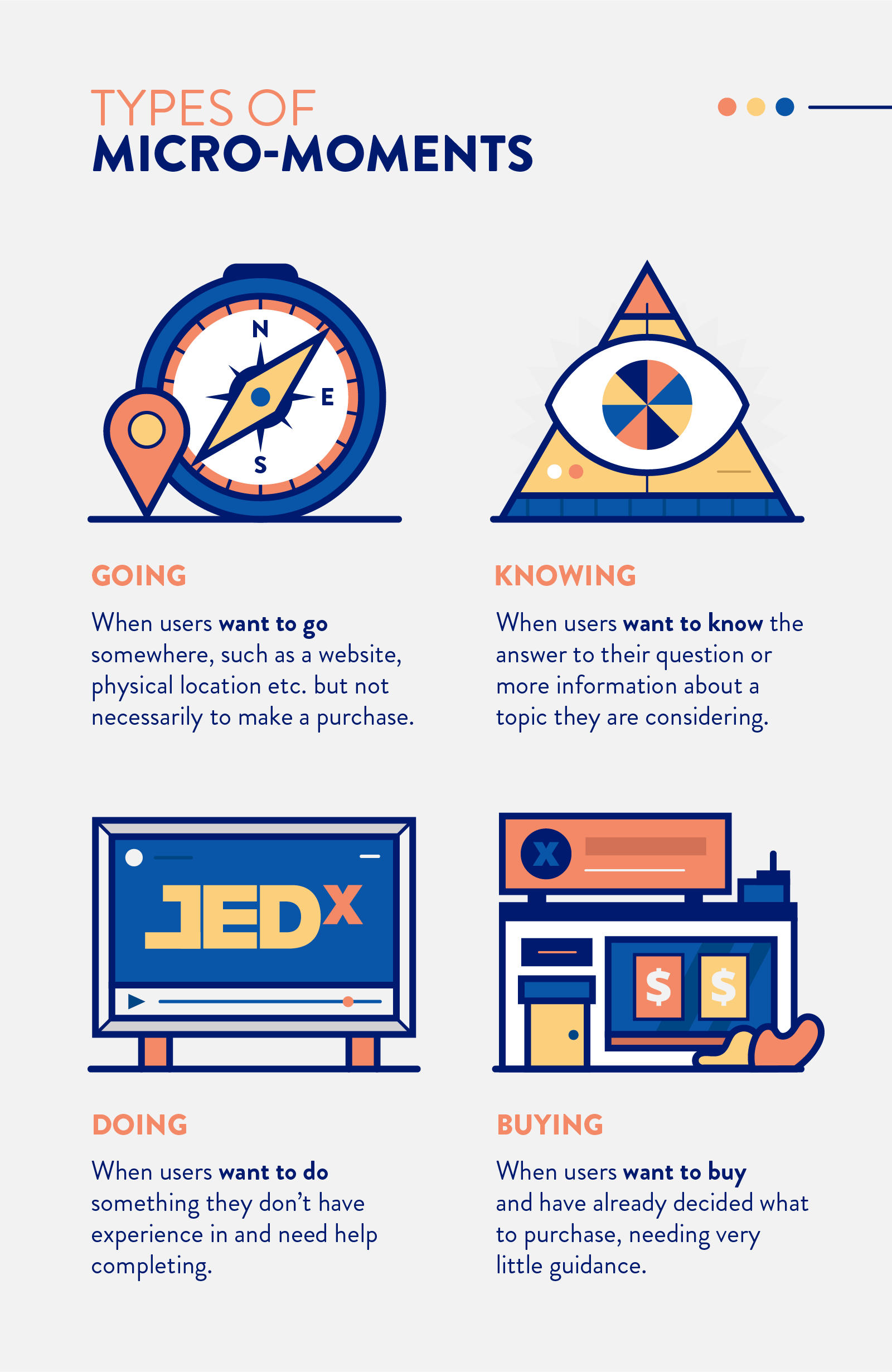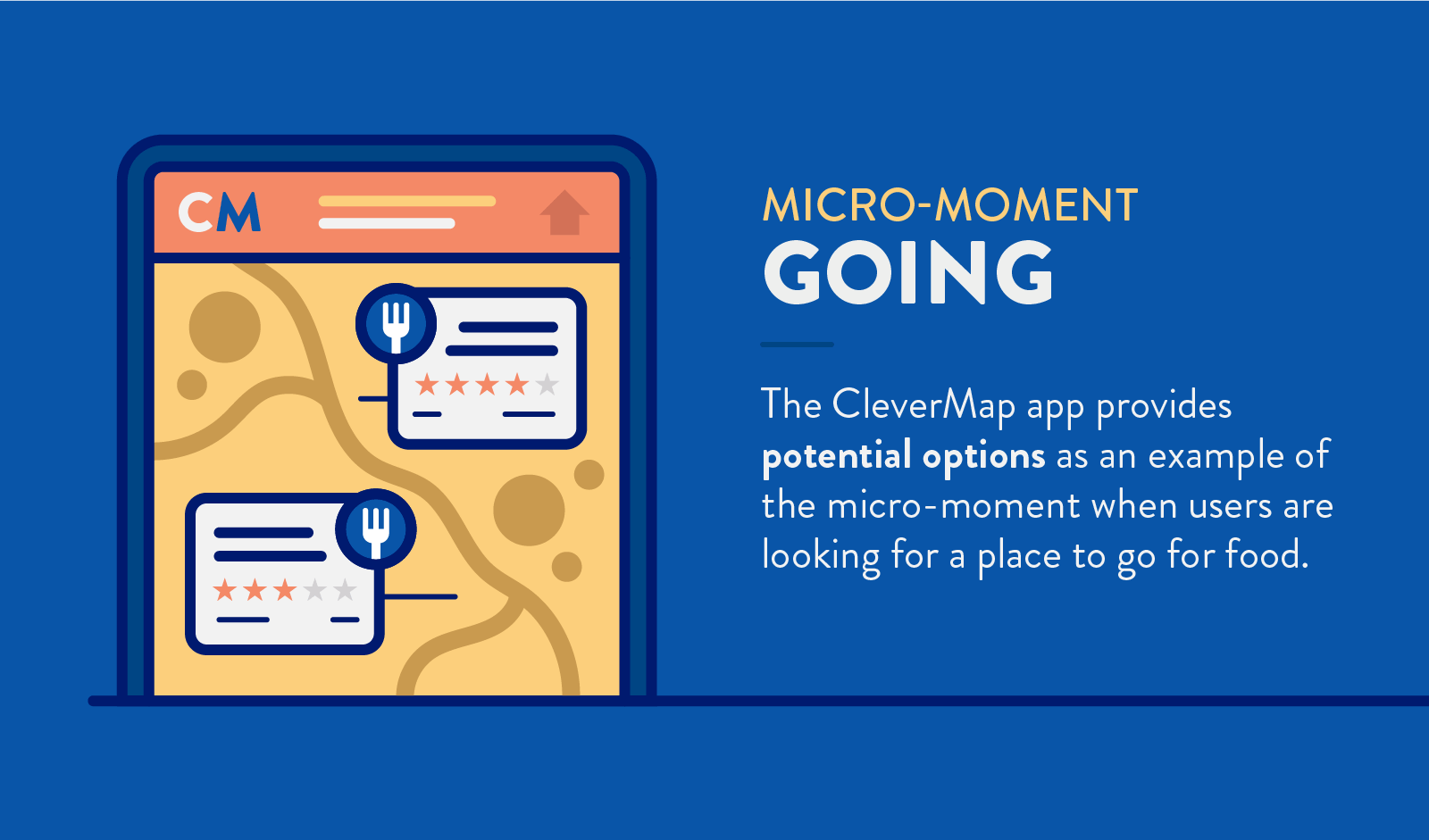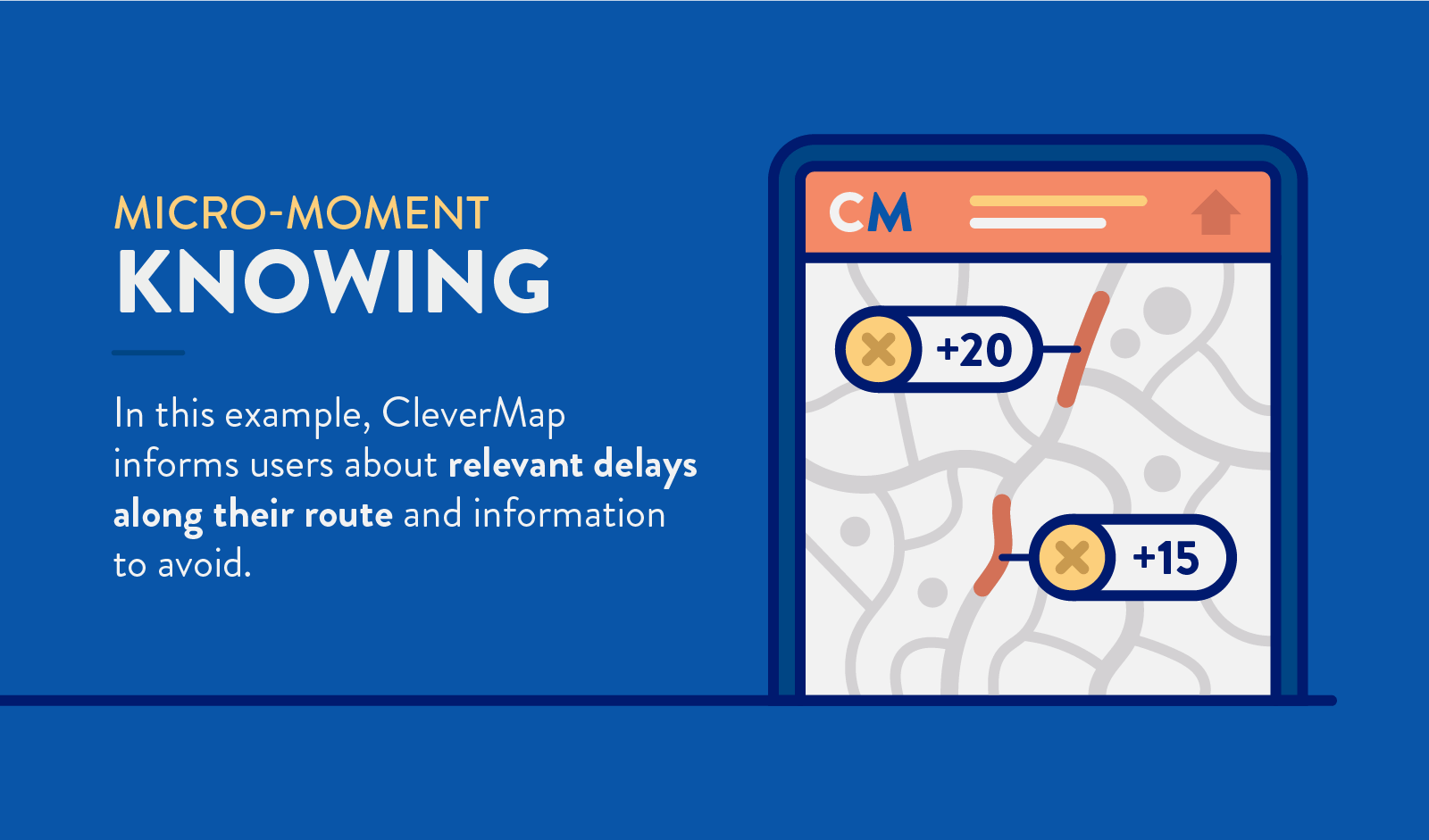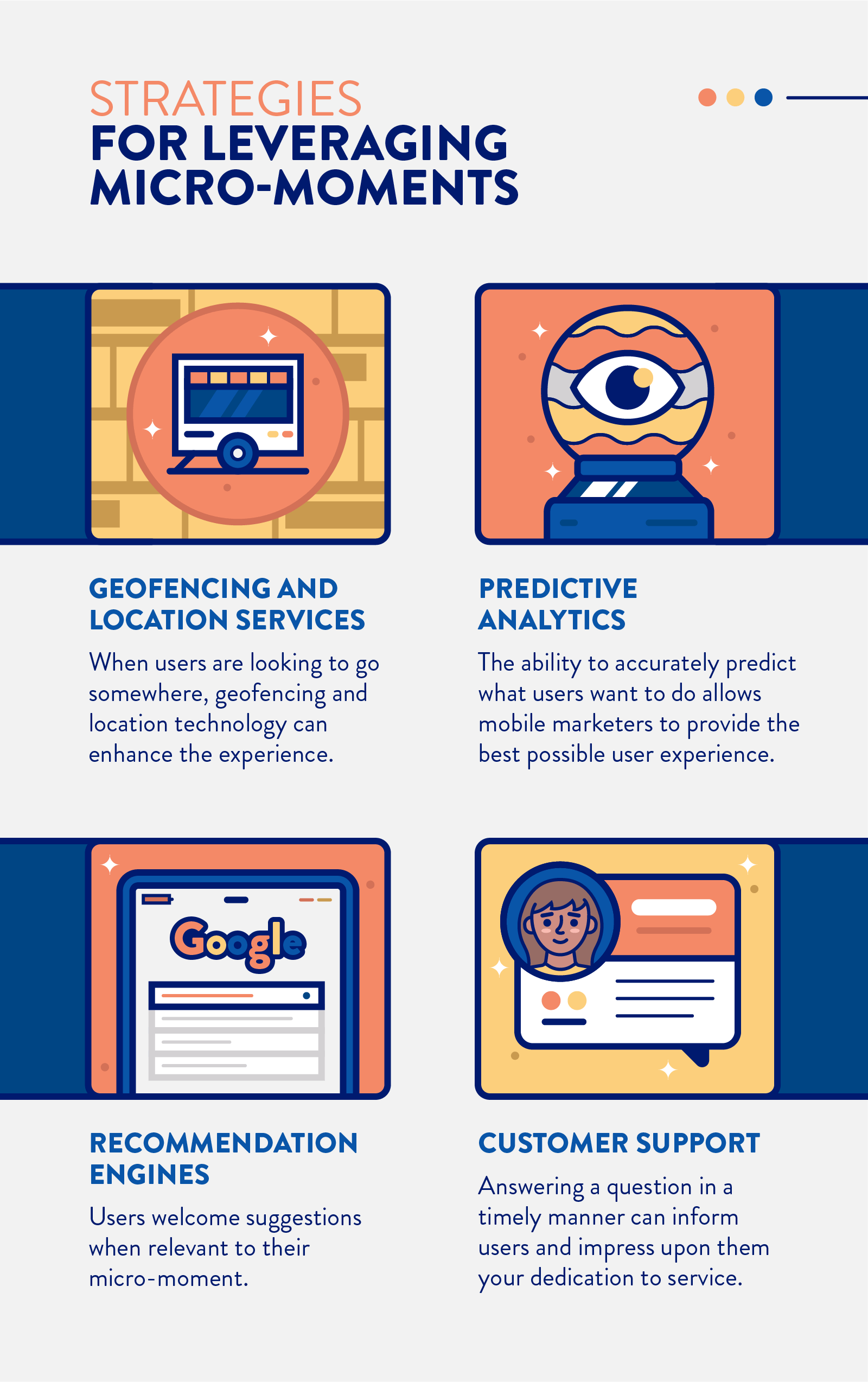Give the people what they want.
As mobile marketers, understanding what users want is a form of clairvoyance. We follow our user journey map and look to provide our users with accurate directions, information, and updates along the way. Whether we use push notifications, in-app messages, or another channel, we always look to add value.
It’s especially important to add value when a user comes looking for quick directions, instructions, information, or updates. This situation is known as a micro-moment. Continue reading to learn more about micro-moments or jump to our infographic below.
What Are Micro-Moments?
Micro-moments are when users turn to an app, product, or device to satisfy their impulse to learn something, do something, or buy something.
These moments are where you must accurately match intent with content. Search engines may be the clearest example of how important these micro-moments are. Matching search intent with the most relevant results possible is the goal of every search engine.
Search engines are not the only applications of micro-moments, however. Mobile marketers must get these moments right because users are impatient and easily distracted. If you take too long, users will look to your competitor for a faster solution.
These are not to be confused with microinteractions or aha moments, where the user must figure out what the app or product is or does. With micro-moments, the onus is on the mobile marketer to quickly connect the dots for the user.
Types of Micro-Moments on Mobile
People turn to their phones for nearly everything — an average of 47 times per day.1
When people want something, whether it be information, entertainment, or otherwise, they pick up their mobile device. These micro-moments are opportunities for mobile marketers to connect with users.
If your users are laser-focused on the task at hand and you interrupt them with an irrelevant message, it’s like giving someone a wrong direction to exit the freeway, consequently losing their trust in your app.
There are 4 high-level factors that inspire micro-moments:
Micro-moments are like individual components of the marketing funnel.
Prospective customers start with awareness (need to know), move to consideration (need to go), and finally reach conversion (need to buy).
Let’s dig into some real-world examples of when an app can fulfill a user’s micro-moment wishes head-on.
4 Examples of Micro-Moments on Mobile
Let’s consider a hypothetical Maps mobile app, CleverMap, as an example to illustrate how each of the micro-moments discussed can be effectively used by mobile marketers.
Most mapping apps have micro-moment features that give users directions, information, and updates to satisfy the needs of all users in that moment. For example, if you were planning a trip and wanted to know when to leave, you could quickly find out the estimated trip duration based on current traffic and make plans accordingly.
1. Need to go
If the destination is time-sensitive, like the airport, for example, it’s important to know the fastest route. Providing micro-moment suggestions of alternative routes is a CleverMap feature that can save time while satisfying the user’s need to go.
If a user is driving along the route, but is unhurried and in need of a beverage or meal, the ability to add a stop along the existing route is a great micro-moment feature.
Micro-moments can happen at any time along the five stages of travel, from dreaming, planning, booking, experiencing, and sharing.
2. Need to know
Another type of micro-moment is when a user has an appetite for information.
An example of how CleverMap can satisfy that appetite is when a user is interested in information and updates about a slow-down ahead, for example, what is causing the traffic and the estimated time delay. 
It’s important when users want to know something, that your app provides the most accurate and comprehensive data available.
Even if users are simply looking for details about their settings or account information within your app, you must make this data intuitive and easily accessible in a micro-moment.
3. Need to do
When users come looking to do something, it’s important to provide detailed instructions and easy-to-follow directions.
Consider the cooking instructions on the back of a frozen TV dinner. These instructions must be clear, concise, and idiot-proof. When you are solving for the need to do micro-moment, your instructions must be as clear and approachable as a microwaveable meal.
In the CleverMap example, the app provides step-by-step instructions for users to follow and successfully navigate to their destination. 
4. Need to buy
Possibly the most important micro-moment for businesses is the need to buy — a micro-monetization-moment, if you will.
This occurs when the user has made the decision to purchase an item, but is still not clear where they will make the final purchase. Take the CleverMap app for example, when a driver realizes they need fuel, the need to buy gas is inevitable, but where the purchase is made is not yet clear.
The app quickly provides multiple options with the latest price per gallon of fuel, the station’s location, and if selected, will provide detailed directions to navigate to the selected gas station. 
Micro-Moment of Truth: Strategies for Leveraging Micro-Moments
Mobile marketers can take advantage of micro-moments in many ways. Whether you are trying to persuade users to make a purchase, to answer their inquiry, or to simply scratch the itch they came to your app for, micro-moments are where you provide a solution.
1. Use geofencing and location services
It’s about being in the right place at the right time.
Many people check their phone while inside a retail store and sometimes even search for a better deal online, after confirming the product is what they want. If you don’t want your retail store to turn into a showroom, mobile marketers can utilize geofencing marketing to send deals, coupons, and more.
A food delivery app could also use location services to provide accurate information on restaurants geographically available to each particular user.
2. Take advantage of predictive analytics
Behavioral segmentation and analysis can be used to determine why some individuals come to use your app at various times.
It’s possible that a certain user persona, such as a college student, only orders food on your food delivery app when they have the funds, usually the 1st and 15th of every month — payday.
Using predictive analytics, you determine that users who fit into this persona are more likely to order food on a Friday or Saturday night, even if it doesn’t fall on a payday. Armed with predictive analytics, you can send coupons to incentivize additional purchases throughout the week.
3. Make relevant suggestions
Using a recommendation engine to provide relevant suggestions is vital to keep users engaged.
If you work on a news app, this could mean suggesting related articles to offer even more information on the subject or a similar subject. Amazon is a prime (?) example of this: by including a section of complementary products, they are able to increase customer lifetime value.
4. Be available, responsive, and supportive
If users are caught up in the moment, the last thing they want is unresponsiveness from your support line (or your app).
Considering that 35% of users believe chatbots are not helpful, it’s best to provide 24/7 support that connects your customer with a real person to help diagnose and solve any problems or answer any questions in the micro-moment. And in fact, Data from Comm100 discovered more than 74% of customer service chats were initiated on mobile devices in 2019, a chatbot on mobile should have an easily accessible “escape hatch” to your support team.2 
Micro-Conclusion
Marketing is all about having a meaningful connection with customers or potential customers. It’s not the quantity of time, but the quality that counts.
This is why mobile marketers can be successful in as little as a micro-moment. As our users become less patient and more accustomed to getting their questions answered fast, they will expect a higher level of performance.
One way to ensure you reach that expected performance is to monitor, understand, and learn from each micro-moment along the user journey. The mobile marketing tools built by CleverTap allow you to do this and much more.
For example, using omnichannel triggered campaigns, you can engage users at optimal moments during their individual user experience. 

5 Travel App Notification Tips For The Perfect Take Off
Subharun Mukherjee 
Heads Cross-Functional Marketing.Expert in SaaS Product Marketing, CX & GTM strategies.
Free Customer Engagement Guides
Join our newsletter for actionable tips and proven strategies to grow your business and engage your customers.















































